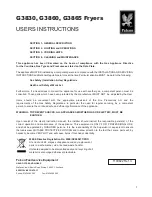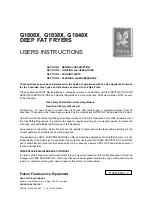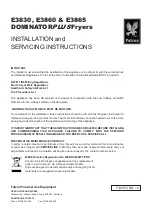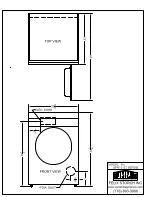
12
INSTALLATION INSTRUCTIONS
www.insigniaproducts.com
Exhausting requirements
• Do not assemble the duct with screws or other fasteners that extend into the duct or that catch lint.
• The exhaust duct should be 4 in. (10.2 cm) in diameter.
• The total length of flexible metal duct should not exceed 7.8 ft. (2.4 m).
• Use only those foil-type flexible ducts, if any, specifically identified for use with your dryer by the manufacturer.
• In the U.S., make sure that the ducts comply with the outline for Clothes Dryer Transition Ducts, Subject 2158A.
See Ducting requirements on page 12 for the maximum duct length and number of bends.
Ducting requirements
Warning
Do not exhaust your dryer into a chimney, a wall, a ceiling, an attic, a crawl
space, or a concealed space in a building.
Your dryer must be exhausted to the outside to reduce the risk of fire when
installed in an alcove or closet.
Exhausting the dryer to the outside prevents large amounts of lint and
moisture from being blown into the room.
Warning
NEVER USE A PLASTIC OR NON-METAL FLEXIBLE DUCT
• If your existing duct work is plastic, non-metal, or combustible, replace it
with metal.
• Use only a metal exhaust duct that is non-flammable to ensure
containment of the exhaust air heat and lint.
Warning
You are responsible for correctly installing the exhaust system.
• Use a 4-inch (10.2 cm) diameter rigid aluminum or rigid galvanized steel duct. Do not use a smaller
duct.
• Ducts larger than 4 inches (10.2 cm) in diameter can result in increased accumulation of lint.
• Lint should be removed regularly.
• If you must use a flexible metal duct, use the type with a stiff sheet metal wall. Do not use a flexible
duct with a thin foil wall. A serious blockage can result if the flexible metal duct is bent too sharply.
• Never install any type of flexible duct in walls, ceilings, or other concealed spaces.
• Keep the exhaust duct as straight and short as possible.
• Secure joints with duct tape. Do not use screws.
• Plastic, flexible ducts can kink, sag, be punctured, reduce airflow, extend drying times, and affect
your dryer’s operation.
• Exhaust systems longer than recommended can extend drying times, affect dryer operations, and
collect lint.
• The exhaust duct should end with an exhaust hood that has a swing-out damper to prevent back
drafts and entry of wildlife. Never use an exhaust hood with a magnetic damper.
• The hood should have at least 12 inches (30.5 cm) of clearance between the bottom of the hood
and the ground or other obstruction. The hood opening should point down.
• Never install a screen over the exhaust outlet.
• To avoid lint buildup, do not exhaust the dryer directly into a window well.
• Do not exhaust under a house or porch.
• If the exhaust duct must run through an unheated area, the duct should be insulated and slope
slightly down towards the exhaust hood to reduce condensation and lint buildup.
• Inspect and clean the interior of the exhaust system at least once a year.
• Unplug the power cord before cleaning.
• Check frequently to make sure that the exhaust hood damper opens and closes freely.
• Check once per month, and clean at least once per year.
Note:
If your clothes are not getting dry,
check the ducting for obstructions.
• Do not exhaust the dryer into a wall, ceiling, crawl space, or concealed space of a building, gas vent,
or any other common duct or chimney. This could create a fire hazard from the lint expelled by the
dryer.
• Do not use non-metallic flexible ducting.
• To reduce the risk of fire, your dryer MUST BE EXHAUSTED OUTDOORS.
NS-FDRE67WH8A-C_NS-FDRE67WH8A_NS-FDRG67WH8A_17-0815_MAN_V5_EN.fm Page 12 Wednesday, November 15, 2017 12:25 PM













































